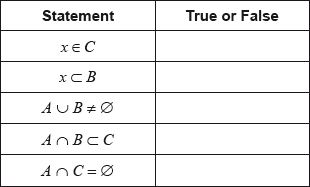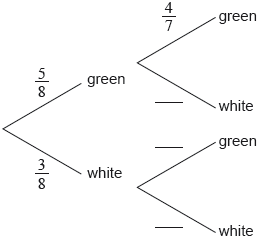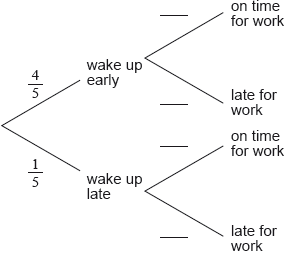| Date | November 2021 | Marks available | 1 | Reference code | 21N.2.AHL.TZ0.3 |
| Level | Additional Higher Level | Paper | Paper 2 | Time zone | Time zone 0 |
| Command term | Find | Question number | 3 | Adapted from | N/A |
Question
Arianne plays a game of darts.
The distance that her darts land from the centre, , of the board can be modelled by a normal distribution with mean and standard deviation .
Find the probability that
Each of Arianne’s throws is independent of her previous throws.
In a competition a player has three darts to throw on each turn. A point is scored if a player throws all three darts to land within a central area around . When Arianne throws a dart the probability that it lands within this area is .
In the competition Arianne has ten turns, each with three darts.
a dart lands less than from .
a dart lands more than from .
Find the probability that Arianne throws two consecutive darts that land more than from .
Find the probability that Arianne does not score a point on a turn of three darts.
Find Arianne’s expected score in the competition.
Find the probability that Arianne scores at least points in the competition.
Find the probability that Arianne scores at least points and less than points.
Given that Arianne scores at least points, find the probability that Arianne scores less than points.
Markscheme
Let be the random variable “distance from ”.
(M1)(A1)
[2 marks]
A1
[1 mark]
(M1)
A1
[2 marks]
(M1)
A1
[2 marks]
let be the random variable “number of points scored”
evidence of use of binomial distribution (M1)
(A1)
(M1)
A1
[4 marks]
A1
[1 mark]
(M1)
A1
Note: Award M1 for a correct probability statement or indication of correct lower and upper bounds, and .
[2 marks]
(M1)
A1
[2 marks]
Examiners report
Most candidates started this question well and applied the normal distribution correctly in part (a). The same goes for part (b) where the candidates were able to combine probabilities correctly. Part (c) was not very well done, and there were a surprising number of incorrect approaches on a seemingly straightforward problem. This suggests that candidates were not interpreting the problem correctly and there was a lack of careful reading to be sure of the scenario being described. In part (d) most candidates recognized the need to model the situation with the binomial distribution. However, many candidates did not choose a correct probability for the Bernoulli trial in this question and oversimplified the problem. This again seems to be a problem of “interpretation” rather than “conceptual understanding”.
Most candidates started this question well and applied the normal distribution correctly in part (a). The same goes for part (b) where the candidates were able to combine probabilities correctly. Part (c) was not very well done, and there were a surprising number of incorrect approaches on a seemingly straightforward problem. This suggests that candidates were not interpreting the problem correctly and there was a lack of careful reading to be sure of the scenario being described. In part (d) most candidates recognized the need to model the situation with the binomial distribution. However, many candidates did not choose a correct probability for the Bernoulli trial in this question and oversimplified the problem. This again seems to be a problem of “interpretation” rather than “conceptual understanding”.
Most candidates started this question well and applied the normal distribution correctly in part (a). The same goes for part (b) where the candidates were able to combine probabilities correctly. Part (c) was not very well done, and there were a surprising number of incorrect approaches on a seemingly straightforward problem. This suggests that candidates were not interpreting the problem correctly and there was a lack of careful reading to be sure of the scenario being described. In part (d) most candidates recognized the need to model the situation with the binomial distribution. However, many candidates did not choose a correct probability for the Bernoulli trial in this question and oversimplified the problem. This again seems to be a problem of “interpretation” rather than “conceptual understanding”.
Most candidates started this question well and applied the normal distribution correctly in part (a). The same goes for part (b) where the candidates were able to combine probabilities correctly. Part (c) was not very well done, and there were a surprising number of incorrect approaches on a seemingly straightforward problem. This suggests that candidates were not interpreting the problem correctly and there was a lack of careful reading to be sure of the scenario being described. In part (d) most candidates recognized the need to model the situation with the binomial distribution. However, many candidates did not choose a correct probability for the Bernoulli trial in this question and oversimplified the problem. This again seems to be a problem of “interpretation” rather than “conceptual understanding”.
Most candidates started this question well and applied the normal distribution correctly in part (a). The same goes for part (b) where the candidates were able to combine probabilities correctly. Part (c) was not very well done, and there were a surprising number of incorrect approaches on a seemingly straightforward problem. This suggests that candidates were not interpreting the problem correctly and there was a lack of careful reading to be sure of the scenario being described. In part (d) most candidates recognized the need to model the situation with the binomial distribution. However, many candidates did not choose a correct probability for the Bernoulli trial in this question and oversimplified the problem. This again seems to be a problem of “interpretation” rather than “conceptual understanding”.
Most candidates started this question well and applied the normal distribution correctly in part (a). The same goes for part (b) where the candidates were able to combine probabilities correctly. Part (c) was not very well done, and there were a surprising number of incorrect approaches on a seemingly straightforward problem. This suggests that candidates were not interpreting the problem correctly and there was a lack of careful reading to be sure of the scenario being described. In part (d) most candidates recognized the need to model the situation with the binomial distribution. However, many candidates did not choose a correct probability for the Bernoulli trial in this question and oversimplified the problem. This again seems to be a problem of “interpretation” rather than “conceptual understanding”.
Most candidates started this question well and applied the normal distribution correctly in part (a). The same goes for part (b) where the candidates were able to combine probabilities correctly. Part (c) was not very well done, and there were a surprising number of incorrect approaches on a seemingly straightforward problem. This suggests that candidates were not interpreting the problem correctly and there was a lack of careful reading to be sure of the scenario being described. In part (d) most candidates recognized the need to model the situation with the binomial distribution. However, many candidates did not choose a correct probability for the Bernoulli trial in this question and oversimplified the problem. This again seems to be a problem of “interpretation” rather than “conceptual understanding”.
Most candidates started this question well and applied the normal distribution correctly in part (a). The same goes for part (b) where the candidates were able to combine probabilities correctly. Part (c) was not very well done, and there were a surprising number of incorrect approaches on a seemingly straightforward problem. This suggests that candidates were not interpreting the problem correctly and there was a lack of careful reading to be sure of the scenario being described. In part (d) most candidates recognized the need to model the situation with the binomial distribution. However, many candidates did not choose a correct probability for the Bernoulli trial in this question and oversimplified the problem. This again seems to be a problem of “interpretation” rather than “conceptual understanding”.





